Chapter 5
Steering Out of Trouble
A bicycle is a highly maneuverable machine, but it stays upright only by being balanced. You have to watch the road for hazards that can cause a fall. A skillful turn can also prevent a collision.
Beware of any slippery or loose surface, including gravel, snow, ice, leaves, oil patches, wet manhole covers, wooden planks and painted markings. Avoid these, or ride over them at a moderate speed. Don’t turn, brake or accelerate. Be ready to put a foot down for balance. Don’t ride through a puddle or pile of leaves where you can’t see the road surface.
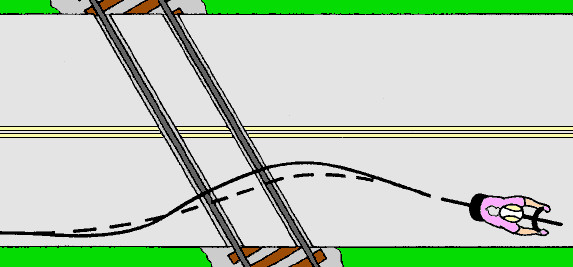
Check behind yourself for traffic, then cross a diagonal railroad crossing more nearly at a right angle.
Be especially careful of diagonal railroad crossings, trolley tracks, raised lane-line dots, steel plates in a construction zone, or a step between the shoulder and the travel lane. Any of these can push your front wheel to the side and sweep your bicycle out from under you. In rangelands, cattle guards are another common hazard. When you can’t avoid one of these hazards, cross it as nearly as possible at a right angle, or dismount and walk if you’re not sure you can cross safely.
Turn in advance if needed to cross squarely – avoid turning or changing speed while crossing. Cross at moderate speed but don’t slow too much or you might lose control. Hold the handlebars firmly. Coast while crossing if the surface is wet or slippery. Be alert to avoid additional gaps or ridges. To reduce the shock, rise off the saddle as you cross, using your knees and elbows as shock absorbers.
Beware of steel-grid bridge decks, which, especially when wet, may steer your bike parallel to the gridding, making balancing difficult. Test a grid deck at a low speed, and if necessary walk, using the bridge sidewalk.
Drain grates with slots parallel to the road pose a special hazard. Be sure to avoid them. Your front wheel can fall into a grate, pitching you over the handlebars. Most often they are at the edge of the road, but watch for them at all low points. It’s a good idea to notify the applicable road or public works department of these and other hazards, as they are dangerous to bicyclists, and a liability issue. The fingers of bridge expansion joints can pose a similar hazard.
Any bump, rock or pothole more than about an inch high can squash a tire against the rim, causing a flat or damaging a wheel. Avoid the bumps if you can, and walk your bike if the going gets too rough.
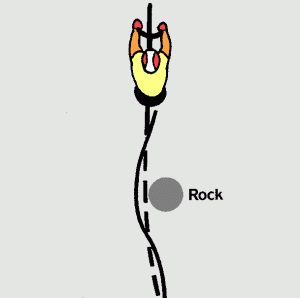
Avoid a rock by turning the handlebars to one side; then correct your balance by turning them the other way.
Good News
Now for the good news: Thanks to your bicycle’s small size and quick steering, you can prepare yourself for situations like this one:
It’s a pleasant, two-lane country road, just wide enough for cars to pass you in your lane. You look up at the scenery and then down at the road. There’s a rock directly in front of you. And there’s a car just behind you. You can’t swerve left into the traffic and you don’t want to swerve to the right, into the gravel and dirt. What to do?
Make your wheels weave around the rock while riding in a straight line – the rock-dodge maneuver. Just as you reach the rock, steer quickly left, then steer right to correct your balance, then straight again.
Because you correct the balance quickly, your body doesn’t have time to follow the bike’s weave. You continue nearly in a straight line. To give yourself better odds against rocks and potholes, go to an empty parking lot and practice the rock dodge until it becomes easy.
Quick Turns

To turn sharply right, first twitch the handlebars momentarily to the left, causing a lean to the right and enabling a quicker turn.
Picture yourself in another pinch: You’re riding along a street, approaching an intersection, and a car on your left suddenly begins a right turn. You are about to crash into the side of the car! You have to turn quickly alongside the car to get out of trouble. To begin a turn quickly, you have to lean your bike quickly. But how do you do that?
Your bicycle balances the same way you balance a yardstick upright on the palm of your hand. To move the yardstick to the right, you move your hand to the left. Then, the yardstick leans to the right, and you follow it with your hand.
Just the same way, if you steer your bicycle out from under you to the left for a moment, you can then turn to the right. You must first steer momentarily toward the car you’re trying to avoid.
Try this technique in your parking-lot practice area. At slow speeds at first, yank the handlebars quickly to the left. Your bicycle will lean to the right, and then you can steer right. Practice first at slow speeds, then at faster ones. The faster you go, the less sharply you have to steer.
The quick turn is useful in many situations. If a car coming toward you begins a left turn, turn right into the side street with it. If a car pulls out of a side street from the right, swerve into the side street. It’s best to turn to the right, behind the car – but if it’s too late for that, turn left with the car. Even if you strike the car, the more nearly you are traveling in the same direction, the lighter the impact.
Too Fast!
On a winding downhill, brake before you enter the turns, so you don’t lose traction while turning. Also don’t forget to raise the inside pedal. But sooner or later, you may find yourself going around a downhill curve too fast. If it’s too late to slow down, a variation on the quick turn can get you through this situation safely.
The usual, panic reaction is to steer straight and brake. But then you’re likely to go headfirst off the road before you can stop. Instead, steer with the curve. Don’t brake. Straighten the handlebars momentarily, as in the quick turn, to drop your bike into a deeper lean.
Usually, you’ll make it around the curve – your tires have more traction than you normally use. If you do skid out, you’ll fall on your side and slide to a stop.
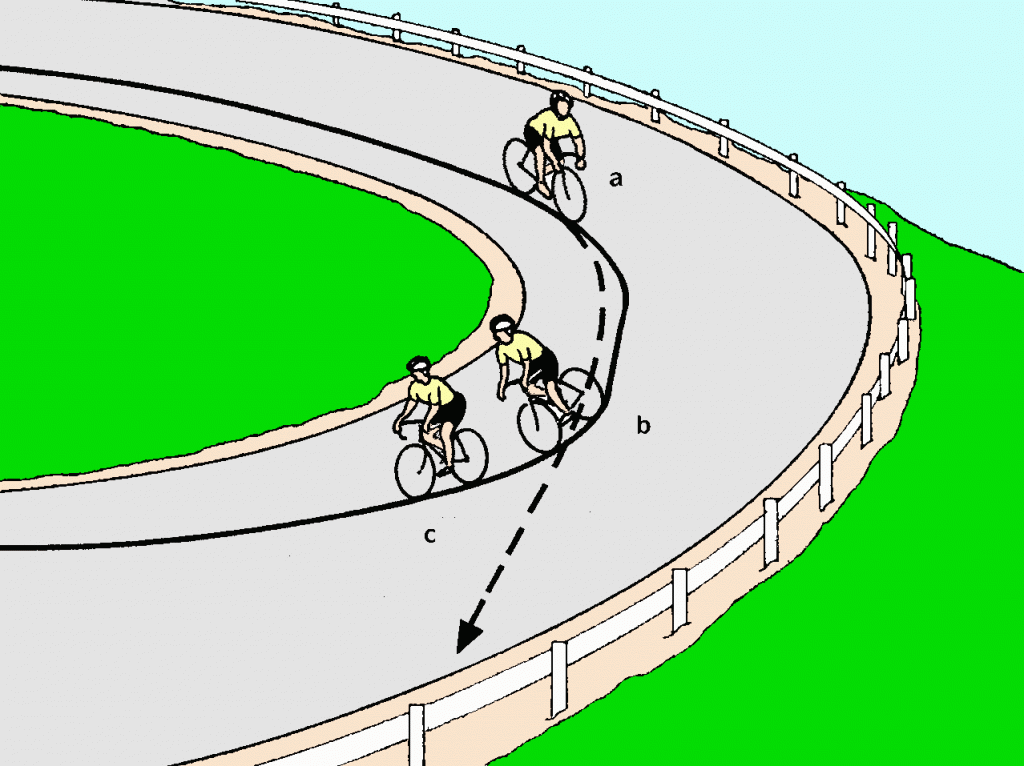
If you’re going around a curve too fast, straighten the handlebars momentarily to drop into a deeper lean. The same bicyclist is shown three times. (a): in trouble, going too fast; (b): has straightened the handlebars momentarily, to lean more steeply; (c): out of trouble.
If you’re about to ride into a wall or over a cliff, you may decide deliberately to skid out. Lean into a turn, then hit the brakes. The fall may hurt – but not as much as the alternative.
Jump?
There is a pothole straight ahead, and no time for even a rock dodge. You were so busy looking up at the traffic that you didn’t see the pothole, and now you’re about to trash your wheels and maybe fall. If only you could fly . . .
Unfortunately, you can’t fly your bike like the kid in the movie E.T., but you can jump your bike. Holding the pedals horizontal, squat down and pull up on the handlebars. Then jump up and yank your legs up under you. You’ll be past the pothole faster than reading “squat-pull-jump-yank.” You can more easily get your back wheel over the obstruction if you use toeclips or clip-in pedals, but getting your front wheel over will usually prevent a crash.
Jumping is the quickest last-resort to avoid a pothole or other road-surface hazard. Once you get good at it, you can even use it to climb low curbs or to cross diagonal railroad tracks. In your empty parking lot, practice jumping your bike. You must lift first the front wheel, then the rear wheel as it takes its turn with the bump. Your timing depends on how fast you’re riding. Skillful off-road riders accelerate to lift the front wheel, but this requires more preparation.
Summary
Once you know your emergency maneuvers, you’ll gain a much expanded sense of security, confidence and style. You can be relaxed while still alert for road or traffic hazards, and when you encounter one you’ll be much more likely to avoid it.

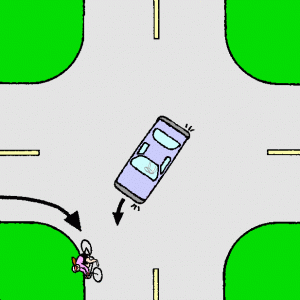
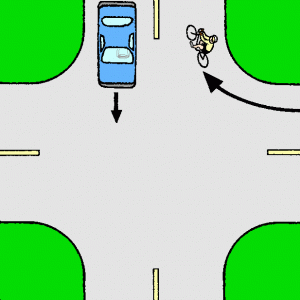

Some redundancy between collision-avoidance examples and illustrations and those in Chapter 9. Keep all of them? Yes, we decided to keep them – the context and emphasis is quite different, and the quick-turn illustrations in the printed booklet are already very small.
Andy wrote: Good spotting… The 1st of these is like ch2 illustration (p12 in printed generic booklet) “In a wide lane…” The next 2 are similar to ch9 rude/bad driver illustrations. The text in this chapter immediately following these illustrations also describes the 2nd two situations. The main difference is the context here of “quick turns” as opposed to “wide lanes” (ch2) or “bad drivers” (ch9). We (JA&AR) decided to leave them in, see also previous comment.
Stop sign needs to be added to the avoiding stop-sign runner photo.
I haven’t figured out yet how to get the three crash-avoidance illustrations to line up in WordPress so they alternate left and right.
Railroad track illustration is downsized Web version because others are all in portrait orientation.